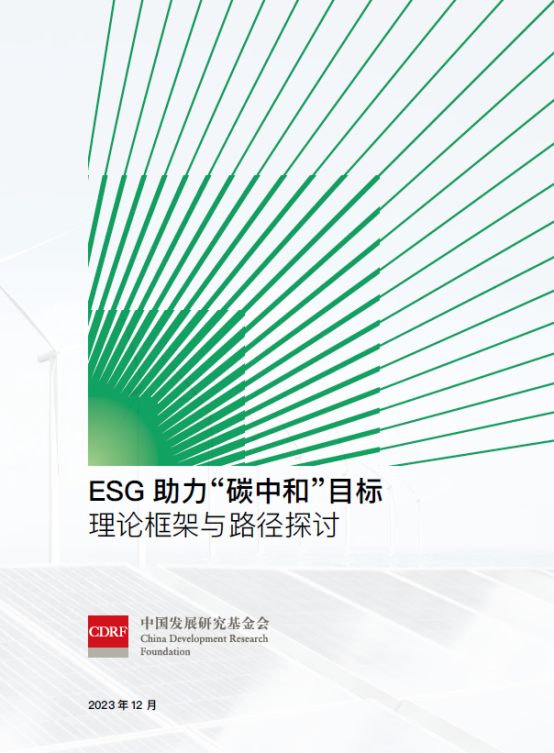Contributing to the Carbon Neutrality Goal through High-Level ESG Practices
China Development Research Foundation (CDRF) has completed and launched the
Report on ESG for Carbon Neutrality. A research team was coordinated by CDRF to
study ESG policy frameworks, ESG ratings, and investment practices relating to
carbon neutrality. The resulting report, based on the current status and trend
of ESG practices at home and abroad, proposes a theoretical framework for ESG to
contribute to carbon neutrality, analyzes seven pathways for ESG to affect
decarbonization, delineate current challenges, and finally puts forward policy
recommendations in the hope of providing a reference for better utilizing ESG to
advance carbon neutrality and China's high-quality development.

Researchers from the Dual Carbon Goals Research Centre of the Chinese Academy
of Environmental Planning, the China Macroeconomic Research Institute, Syntao
Green Finance, the China ESG Research Institute of Capital University of
Economics and Business, the International Institute of Green Finance of the
Central University of Finance and Economics, Shanghai University of Finance and
Economics, Research Centre of SASAC participated in producing subject
reports.
The report points out that ESG can be a key factor in the green transition,
that it is naturally consistent with carbon neutrality and sustainable
development goals, and that it is compatible with China's new development
philosophy of innovation, coordination, greenness, openness, and sharing. ESG
framework already incorporates climate change and carbon neutrality issues, it
is also integrated, synergistic, and flexible. ESG can be embedded in
market-based mechanisms and is a comprehensive governance tool that can be used
by financial institutions, enterprises, governments, society and international
organizations to promote carbon neutrality. The introduction of dual carbon
goals has provided extensive opportunities for ESG practice and development in
China, and more and more enterprises and organizations in China are paying
attention to ESG practice and investment.
The report proposes a theoretical framework on how ESG can contribute to
carbon neutrality, centered on the relationship between enterprises, government
and society. On this basis, the report analyses seven pathways and corresponding
practice cases for ESG to contribute to carbon neutrality. The seven pathways
are: reshaping governance structure, directing financial investment, encouraging
green technological innovation, promoting transformation and upgrading of
high-carbon industries, driving carbon reduction in the supply chain, promoting
carbon disclosure through supervision and regulation, and enabling low-carbon
development through policy support.
The report curates best practice case studies such as Brookfield Asset
Management, Bank of Beijing, Geely Digital, China Energy Group, etc., and
further demonstrates in detail the active exploration of financial institutions,
technology enterprises and enterprises in high-carbon industries in applying ESG
to assist low-carbon transformation and high-quality development from different
perspectives.
The report points out that ESG has been practiced and explored in
contributing to carbon neutral goals, but there are still many challenges and
deficiencies. For example, the overall understanding of ESG is insufficient, the
infrastructure for carbon accounting is insufficient, the coverage and quality
of ESG and carbon disclosure are poor, the authority and credibility of ESG
ratings are lacking, it is difficult to integrate ESG into corporate business
strategies, and there are misunderstandings about ESG investment.
The report puts forward the following recommendations:
First, improve the top-level design of ESG framework. Promote the formation
of an integrated ESG policy framework, establish an ESG standard system in line
with international standards and with Chinese characteristics, set up a
timetable and roadmap, and strengthen the guidance of expectations.
Second, improving the carbon emission accounting system, including
accelerating the updating of accounting methods, standardizing the accounting
scopes and boundaries at the regional level, increasing the use of digital
technology, enhancing the efficiency of the whole process of emission
management, improving the standardization and encouraging participation,
strengthening the level of monitoring and supervision of carbon emissions, and
establishing a sound system for disclosing corporate carbon emission.
Third, improve the construction of ESG ecosystem, further strengthen the
construction of ESG data infrastructure, improve the ESG capability and
disclosure level of enterprises, highlight the leading role of state-owned
enterprises, guide the participation of financial institutions and ESG rating
agencies, and give play to the guiding role of the government.
Fourth, strengthen the innovation of financial products and services oriented
towards carbon neutrality, promote ESG product standards and operation mechanism
from the policy end, financial institutions in the market end should incorporate
ESG standards into the whole process of investment management, and in the
product end it is suggested to improve the variety and quality of ESG financial
products.
Fifthly, we should build a carbon neutral ESG practice support system through
policy incentives for corporations, capacity building for climate-related risk
assessment and management, enhancing professional talent training, expanding
international exchanges and cooperation, and promoting the dissemination of ESG
concepts.
Link to the report (in Chinese)





